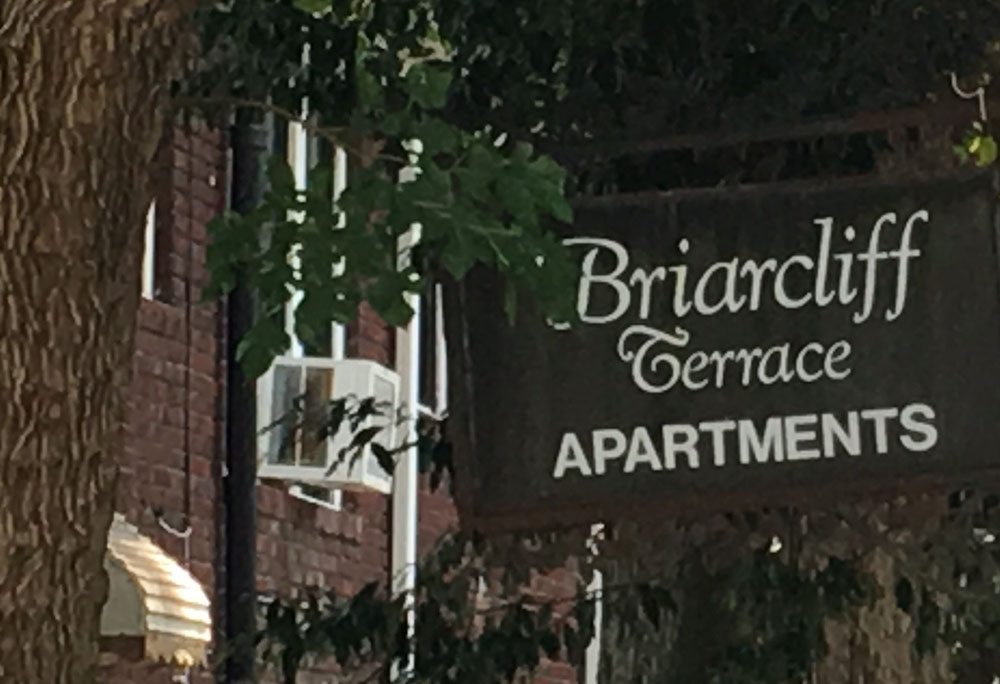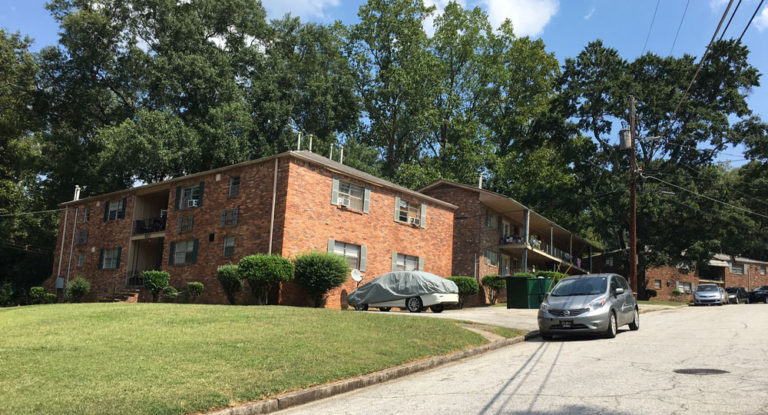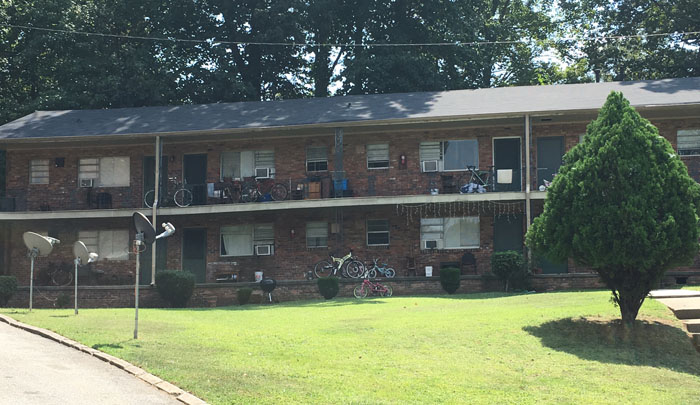Briarcliff Terrace Apartments Redevelopment Plans on Hold
 The developerrs at Briarcliff Terrace Apartments Place have communicated (attorney to attorney) that they will not be introducing ‘at this time’ a proposal to redevelop their site from its existing designation of RG2 to either RG3 or to a PDH (Planned Development Housing) zoning category.
The developerrs at Briarcliff Terrace Apartments Place have communicated (attorney to attorney) that they will not be introducing ‘at this time’ a proposal to redevelop their site from its existing designation of RG2 to either RG3 or to a PDH (Planned Development Housing) zoning category.
(This site is located downhill below the Highland CVS, bounded by Rosedale Drive on the north, Rosedale Road on the east, Briarcliff Place on the south, and Arlington Place on the west. It contains about 145 one, two, and three-bedroom units, plus two small homes, all built in the 1960’s. One small street bisects the property north-south, which for many years has been a quiet and stable home to a group of mostly Latino residents, including many children.)
This decision does not mean that the owners or developers won’t change their mind in the future, even the near future. One can always ask to change the zoning or land use, as they were contemplating. Or they might choose to redevelop it within existing density guidelines, which was and is a readily available option. (More on that in a moment.)
Some form of redevelopment here has seemed certain for years, and the zoning and land use were reviewed during our Master Plan Process. No changes in either category were suggested then, and no compelling reasons for new ones have been identified since.
Looking at how this process played out offers a chance to see how the VHCA Board and Planning Committee have approached issues of this type over the last few years.
The ownership and development group met several times with VHCA and its zoning and planning consultants. The VHCA Planning Committee has made such meetings standard in the last five years; they are a useful way to understand goals. After the first meeting, we immediately checked in with our councilmember to make sure that he had the same understanding that we did (many developers meet first with the local councilmember on issues like this), and we did the same with the NPU Planning Chair, who had also met with them. And we carefully looked at the physical features of the site.
The applicants emphasized that while their plans were not final, they anticipated increasing the amount of developed space – the density, defined in the code as FAR, Floor Area Ratio – by about 50%, even though the number of units would be about the same. (Obviously – and as one might expect – the new units were going to be a lot larger.) The use of Planned Development Housing as a design tool was mentioned.
PDH is a useful concept, and it can be employed in any zoning category. It offers architects the chance of creating unique and innovative plans that can protect natural resources (perhaps voluntarily save trees or protect riparian areas), maximize green spaces, and (conceivably) avoid boxlike designs.
But the City of Atlanta has a long-standing policy that controls PDH rezonings that limits the allowable density to the level already in place on a property. This property’s density was RG2; in this case, the City support of a rezoning to PDH would remain capped at the RG2 density, which is .348
Their proposal – at least as presented – had a much higher level: a FAR of about .57
As we examined this with our consultants, an even more fundamental concern with the proposed new density emerged. This particular site represents a small fraction of the total amount of property within the Virginia-Highland neighborhood that is zoned RG2. While many of them are smaller, these properties have much in common with Briarcliff Terrace: they are inside the neighborhood (not fronting along major thoroughfares), are surrounded by single-family residential, and are historically small-scale walk-up apartment types of buildings. There are over 60 acres of “other” RG2-zoned land in the neighborhood, in addition to this 7-acre site.
The outcome of a rezoning application here would set a precedent for those remaining properties in the neighborhood. Planner Aaron Fortner summed it up thusly: What determinative arguments would support the re-zoning of this site from RG2 to RG3 that wouldn’t also apply to the other similarly zoned properties? He concluded that there were no standards or criteria utilized by the City of Atlanta that would meaningfully distinguish this site from the others.
And rezonings are not variances. We take variances seriously and visit every site in an effort to ensure that new proposals will not improperly diminish the value of adjacent properties, but variances are common and are not precedents. Zoning changes are, and they’re tracked carefully by those in the business.
Because what is done on this RG2 property (of 7 acres) would set a precedent for what can happen on the other RG2 properties (60+ acres), a rezoning here would be a powerful tool for supporting similar changes on the other properties.
Nor were there any persuasive arguments offered as to why this property should be rezoned, other than the desire to get more density on it. It certainly has value as an RG2 property. If the existing buildings were removed, the current RG2 zoning would allow about 108,000 s.f. of new development on the site (approximately 10% more than is there now), which could include one or more combinations of the following development types:
Approximately 100+ units of apartments (assumes 1,000 sq. ft/unit);
Approximately 50+ units of townhomes (assumes 2,000 sq. ft/unit);
Approximately 35+ units of single-family houses (assumes 3,000 sq. ft/unit).
There is one last consideration. The NPU-F Comprehensive Development Plan acknowledges that many nonconforming properties are in place and can remain (or be redeveloped at the existing density), but this site’s underlying land use is single-family – a designation that reflects the fact that 100% of the surrounding properties are just that: single-family. Increasing the density (as was being contemplated) would require a land-use challenge to the CDP, an issue that the NPU and all its neighborhoods – including VaHi – take very seriously. Two separate attempts of that type have been rebuffed in NPU-F the last two years. (We wrote about them in the Voice and hosted one large NPU meeting and vote at the VaHi Church.)
This NPU also successfully opposed a similar attempt at Monroe and 10th in 2009. Planning according to the tenets and themes of our Master Plan and the CDP has been a principle for us and NPU-F.
Among our consultants’ goals was investigating whether the City Planning Department was considering changing their own policy to allow a PDH use here that increased density. Once we were confident that the policy was firmly in place and knowing that Councilmember Wan was steadfast in his support of following the existing guidelines, we were hopeful that the developers might rethink their plans, even after they made an unusual private presentation to adjacent neighbors that omitted some key points.
Let’s be clear: Attempts can be made to rezone even in these conditions. But it’s easier for us to make an effective and strong case when we make plausible planning arguments year after year, are consistent and logical in our reasoning, synched with local and city plans, and supported by our local councilmember. Those aren’t guarantees, but those factors matter a lot.
It appears that – for at least the time being – this plan will not be pursued. Of course, that could change, and a new plan could be presented. We’ll be glad to work with the owners and help evaluate it if that happens.
Some of these theoretically public processes tend to be opaque. Hence this article, which aspires to make clearer the sorts of rationales and approaches we use to analyze significant changes in zoning or land use. Having the assistance of knowledgeable planners and land use attorneys costs money, but when it helps the neighborhood evaluate proposals in an orderly fashion according to known principles, it’s money well spent.
(The developers are spending a lot of money, too. Of course, they often stand to get a lot more back.)
A final thought: Employing the Master Plan and CDP and doing methodical systematic reviews of city processes benefits the whole community, not just the closest neighbors. Nearby citizens are often wisely engaged – they would bear the brunt of changes in traffic and noise, and we appreciate hearing from many of them here – but it’s everyone’s battle. The impacts of such projects extend way past the adjacent streets, just as will the outcomes at 10th & Monroe/Cresthill. These are issues that require unblinking attention and real vigilance.
We again salute and thank councilmember Wan for his consistent and supportive stand on issues like this. Many a community has had decent plans but only defended them in a crisis (“Here comes the Big Box Mart”), and many communities have not been consistently supported at the council level. Alex has been a stalwart and a strong advocate for public planning, and it has made his neighborhoods a much better place to live in and encouraged and rewarded citizen involvement.
It’s a long article, and if you’ve read this far, you may be ready to join the Planning Committee. But understanding and identifying the constituent parts have helped us understand this a lot better. It’s an issue (like many) that can for a long time seem like it doesn’t matter much – until suddenly it does, and then it matters a lot.
Your comments and questions are welcome. We frequently discuss these matters at the Planning Committee and Board meetings; those schedules are listed on our calendar at vahi.org.

